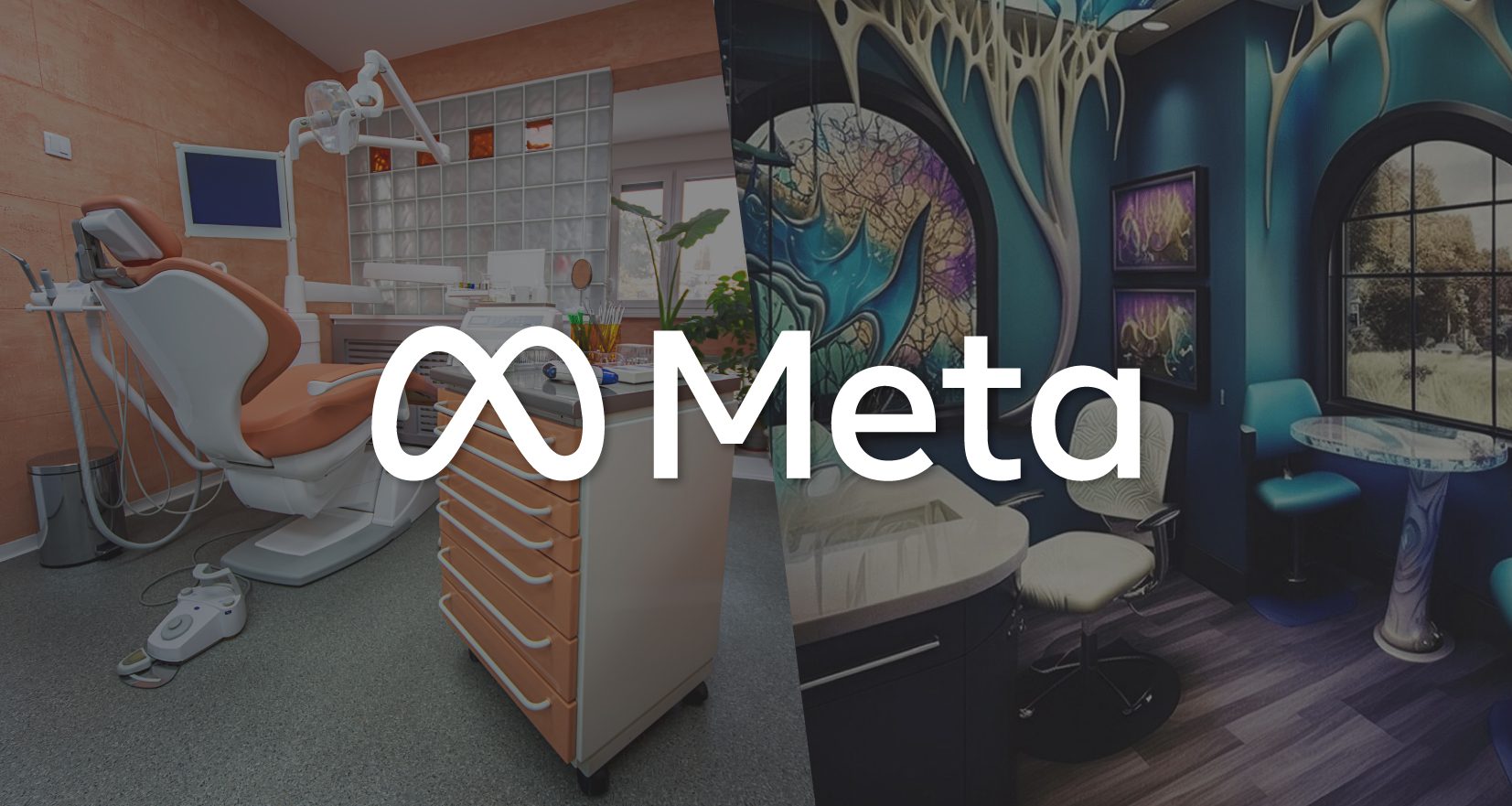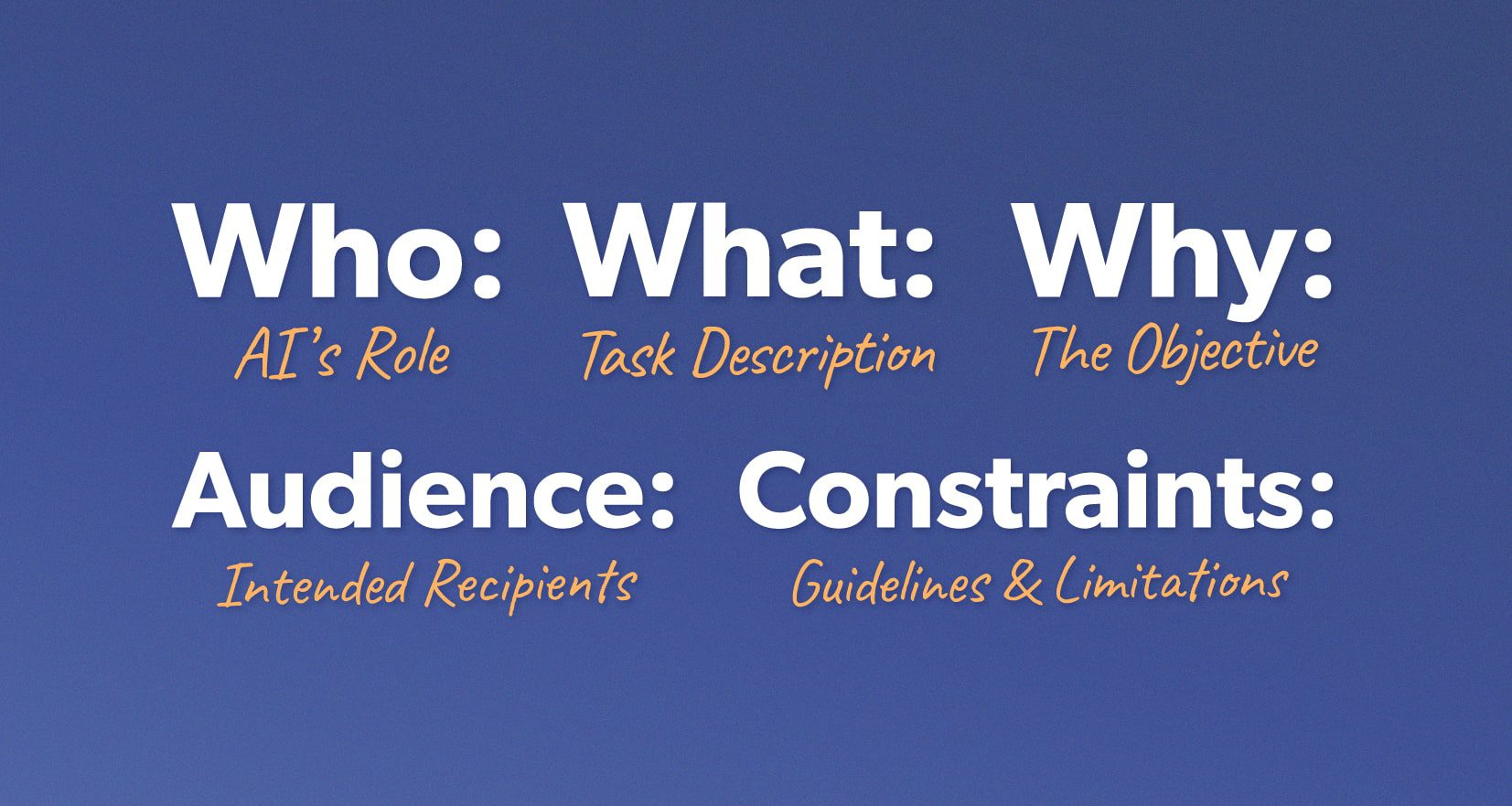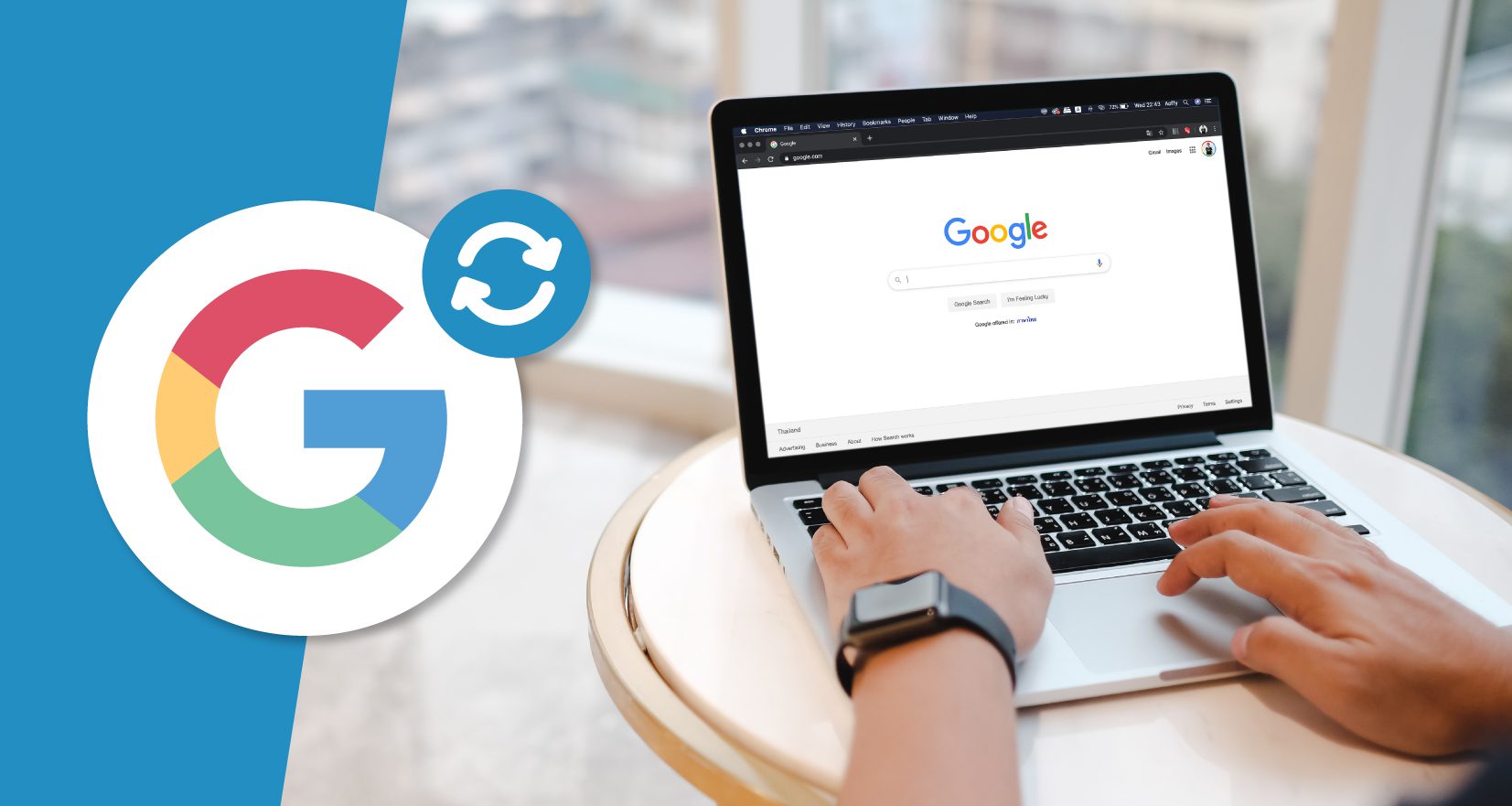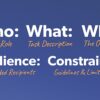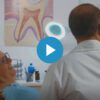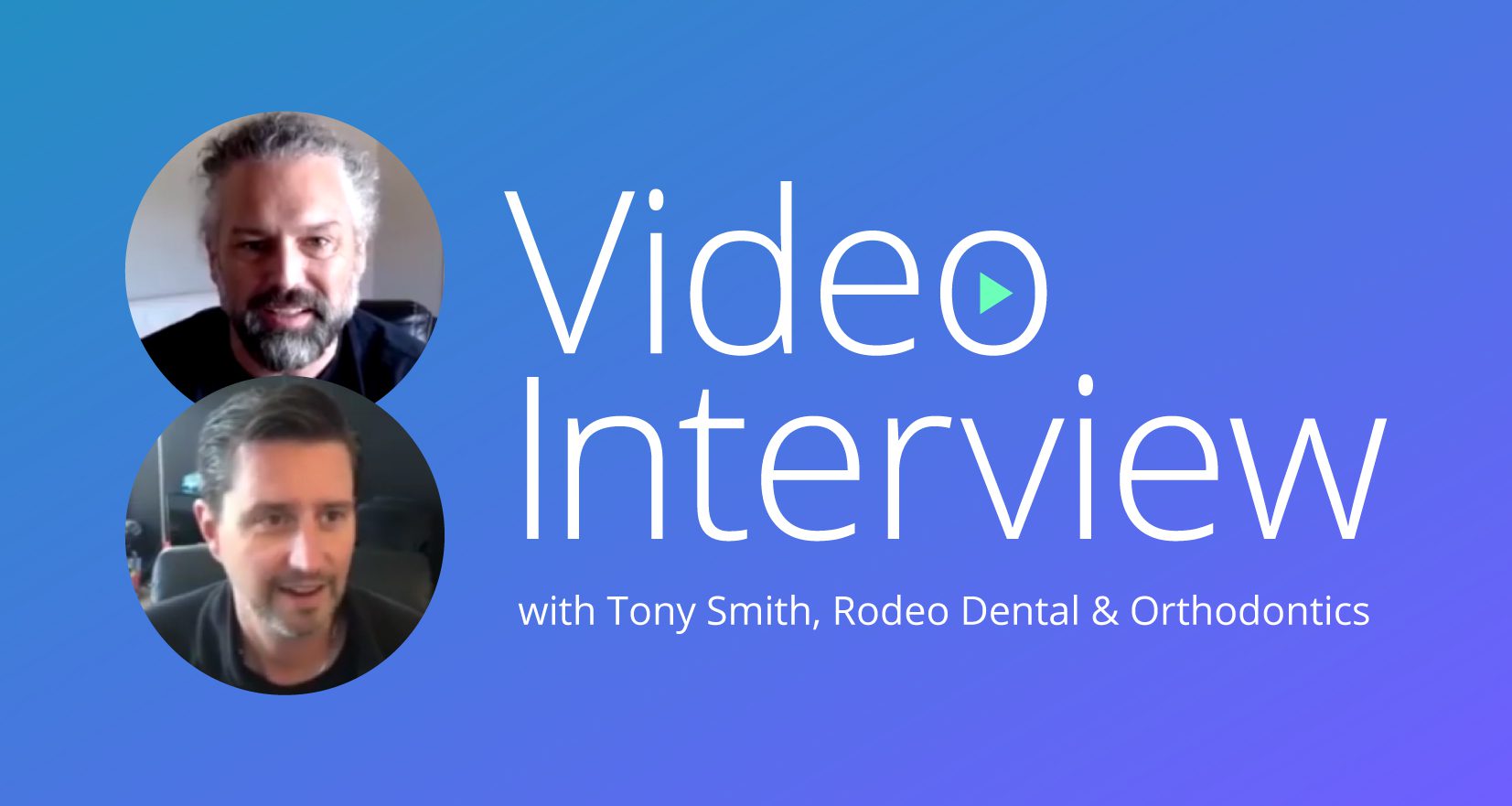
DSO With 50,000+ Google Reviews | Local Dental SEO Interview
At the end of 2021 the dental marketing team at My Social Practice did a study of the dental practices with the most Google reviews. In the study we included all dental practices in the largest 100 cities in the USA.
Rodeo Dental & Orthodontics has thirty two practices in their organization and as of June 2022, they are acquiring three additional practices. Two of their locations, Rodeo Dental & Orthodontics in Fort Worth and Rodeo Dental & Orthodontics in Laredo took up the second and sixth spots of the top ten. A big congrats to their team!
This local dental SEO interview is with Tony Smith the creative director for Rodeo Dental & Orthodontics. Tony is responsible for helping to establish Rodeo Dental & Orthodontics’ creative direction, overall marketing plan, digital marketing initiatives, mission, and review aggregation campaign.
In this interview we ask Tony about their brand, practice methodology, mission, and how they have acquired so many amazing Google reviews.
Meet the Interviewer / Interviewee

Adrian Lefler
Vice President of My Social Practice
Adrian is the Vice President at My Social Practice, an agency providing expert SEO support, social media marketing content, and strategy to dental practices.
Adrian has been involved in Google maps SEO for more than 12 years and has helped thousands of companies grow and thrive through digital marketing. Adrian and his wife Emilie have four children and live in Suncrest, Utah.

Tony Smith
Creative Director of Rodeo Dental & Orthodontics
Before Tony threw his hat in the ring with Rodeo he performed as the Marketing Director at Ironclad Performance Wear. He spearheaded the growth of the design and marketing divisions, while also expanding Ironclad’s online footprint and digital messaging.
Tony has held competitive and demanding positions that required leadership, resolve and patience. One of these positions was Head Coach of the University of Texas Taekwondo Team where he held this position for 8 years. Prior to this coaching position, he was on course for an Olympic dream devoting 20 years of his life in Olympic-style Taekwondo. He finished as a U.S. Team Member and an Olympic hopeful for the 2000 and 2004 U.S. Olympic Team.
Tony is not just a digital marketing guru. His skill set includes: Strategic Planning, Creative Direction, Branding and Identity, Print Design, Website Design, User Interface Design, Video Production, Motion Graphics, Digital Signage, Conceptualization, Consulting, Design Management, Accountability.
Check Out The Interview With Tony!
Webinar Transcript
Adrian lefler:
How you doing?
Tony Smith:
Good. Good. It’s been quite a ride for a long time here, but I’m doing really good. Weather’s cooled off down here, in good old Texas.
Adrian lefler:
Oh, nice.
Tony Smith:
I know it’s been hitting triple digit quite a bit here, but it’s “cooled” off just about four or five degrees.
Adrian lefler:
I’ve got a graphic designer that works for us. He’s in Austin. His AC went out.
Tony Smith:
Mm-hmm (affirmative). Everybody’s is actually going out.
Adrian lefler:
Yeah, he’s not happy. Let me do this. Let me just give kind of a premise for those people who are going to watch this interview, about why I’m calling you. And then I’d love to just get a little bit of information about your background, whatever you’re willing to share, how long you’ve been working with Rodeo, and then any ideas or thoughts that you’re willing to share about how you guys have just totally knocked it out of the park with Google reviews. Is that cool if we go with that kind of format?
Tony Smith:
Yeah, sure.
Adrian lefler:
Okay. So what we did was a dental SEO report at the end of 2021, we took the top 100 largest cities in the United States. We went in and we grabbed all of their Google My Business information. It came to over 28,000 practices. Anybody that’s in a city that’s smaller, that’s like the 100 largest city in the United States, was not included in this.
It’s not a totally comprehensive local SEO for dentists review, but it is the top 100 largest cities. That’s a big deal that you guys have done so well, with that many dental practices, comparing you to that many dental practices.
In the report, we looked at who got the most reviews in the last 30 days, the practices with the most Google reviews, the most Google reviews at a five star rating. I mean, all sorts of stuff. We did a bunch of research on which cities were the most competitive, so which cities were the ones where the dentists and the dental practices were really motivated to get lots of reviews. So, it was a pretty intense local dental SEO report, Google reputation management report.
Anyway, you guys had two practices in the top 10 practices with the most reviews. You had your Laredo location, which was number six on the list. And then you had the Fort Worth location, which was number two, right behind Child Smiles, Family Smiles up in Newark, New Jersey. And I did an interview with Jessica from there. I think I might have sent that to you. You should watch that. She’s really a sharp, sharp marketing manager.
Anyway, congratulations. This is not a small deal. This is a big deal, to have over … When I did the report, your Fort Worth location had just over 3000 Google reviews. That’s massive. And the Laredo location had about 2300.
Tony Smith:
Thanks.
Adrian lefler:
So anyway, big thumbs up. Good job.
Tony Smith:
Thank you.
Adrian lefler:
Yeah, you’re welcome. So why don’t you tell me a little bit about your background, and maybe whatever you’re willing to share about your culture and what you guys have done to try and increase your reviews and what that means to your company. That would be super cool, anything you’re willing to share.
Tony Smith:
Yeah, sure. Well, I’m Tony Smith. I’m the creative director of Rodeo Dental. I handle all the visuals, the messaging, all the outbound visibility of what Rodeo looks like, feels like, tastes like. And also on the internal side, I worked closely with a lot of partners to help deliver on both sides.
Adrian lefler:
Yeah.
Tony Smith:
At one point I was also heavily involved in, and I still am in some capacity, but I did a lot of the digital dental marketing.
Adrian lefler:
Okay.
Tony Smith:
Which, at the time I was running digital marketing. That’s how reputation management ended up in my setup.
Adrian lefler:
Right.
Tony Smith:
Because it was considered as part of a digital marketing arm of sorts.
Adrian lefler:
Yeah. Yeah.
Tony Smith:
And so, I’ve been a creative director here at Rodeo. I’ve been here a little over five and a half years. I come from a design background, actually. And then, over time, I’ve always had a bit of a business acumen to me, and so I merged kind of a business strategic approach with design and you come up with what we call creative solutions.
Adrian lefler:
Yeah.
Tony Smith:
So now I’m in a position where I provide creative solutions, on top of being heavily involved in just the creative and the messaging with Rodeo, but also provide the creative solutions within our company, as well, for challenging business situations. Oftentimes I use a lot of design to help deliver that and put that into a vehicle, the business solution, and use design to create a nice packaging so it gets deployed in a very effective manner.
Adrian lefler:
That’s a really difficult thing to … Well, I’m going to sound dumb saying this, but that’s a really complicated task. It requires … We have a person here at my social practice, he’s my business partner, Blake Hadley, who kind of literally set the standard for the creative design, the branding, the colors, the messaging. And he’s just absolutely brilliant. And it’s so hard to find somebody that can do that and do it well and frankly just understands what it is.
Tony Smith:
Yeah.
Adrian lefler:
So, kudos to you. In terms of design, did you go to school? Did you-
Tony Smith:
I did.
Adrian lefler:
For graphic design?
Tony Smith:
Actually, I went to the Art Institute of Dallas. My whole intention really was, I was wanting to get into video games.
Adrian lefler:
Oh, nice.
Tony Smith:
So I applied for a particular program that you had to get accepted for, into the Art Institute of Dallas, and had to actually have a strong drawing portfolio. So I submitted it, I got accepted, and I was like, “Yay! I’m going to go, and I’m going to make some video games!” You know?
And the more I got into the program, the less I actually started to enjoy video games. And I’m like, “Man, I don’t know if I want to get into something where I’m not going to enjoy what I …” At the time, I was very passionate about that. I was an enthusiast, and I enjoyed the gaming industry in and of itself.
And I started finding myself really critiquing it and analyzing the games that I play. And it wasn’t turning into enjoyment. It was turning into how they were being built and stuff. Which is fine and all.
But the good thing about the program that I was in, when I went into the Art Institute is that because of the degree of skills you need to learn, to be able to be able to go into any sort of video game artistry, any sort of video game … It wasn’t video game development as much as it was more video game design. It could be landscaping, it could be environments, it could be user interface, but you needed to know a lot of stuff in terms of design. And you also need to be versatile, in terms of … Because you might design for different genres, different demographics. I mean, you’ve got a whole slew of stuff. So you had to be very, very versatile.
And so, that translated very well when I decided to go, “You know what? I’m actually going to go more into the commercial art side when I’m finished up here. I’m going to go into the commercial art side, and then I’m going to …” Because I was also taking business classes, too, before I even went to design. And so, and that’s when I decided to go into more of the commercial art side.
And I started off being a graphic designer, then moved to a senior … I did the actual leveling up, throughout the entire time: graphic designer, senior graphic designer, art director, then finally creative director. And then, I’m still right here.
Adrian lefler:
How long have you been working with Rodeo, then?
Tony Smith:
A little over five and a half years.
Adrian lefler:
In your progression in your career, at what point did you move to Rodeo? Were you already an art director or creative director and another company when you came over?
Tony Smith:
Yes, I was. Well, it’s funny. So, the company that I worked at before Rodeo, I was actually a dental marketing director.
Adrian lefler:
Okay, yeah.
Tony Smith:
Which because of the versatility allows me to maneuver between both sides.
Adrian lefler:
Sure, sure.
Tony Smith:
And before that, I worked my way up. I worked at a company where I worked my way up into a creative director role. And then I moved over to the company before Rodeo, to a marketing director. And then from there, I saw Rodeo and decided I wanted to participate in the brand and building it up.
Adrian lefler:
And building the brand. Yeah.
Tony Smith:
Yeah. Absolutely. One thing that really attracted me was, one, I could kind of already see where the brand was wanting to go, but it just has not been, it was not developed to the level at which … To its potential. And it still hasn’t yet. We’ve still got so much more to ultimately do.
But I liked looking at it and seeing it going, “Yes, I can participate there, there, there, and there, and there.” I don’t want to go and participate in a company that it’s already built and now I’m just coming in and doing a bunch of PowerPoints.
Adrian lefler:
Yeah, yeah, yeah. Yeah, yeah.
Tony Smith:
No. I come in, I want to roll my sleeves up-
Adrian lefler:
What’s interesting is, for a dentist who’s watching this video and is listening to your history, one of the things that I don’t think many small business owners know … Now, Rodeo is not necessarily a small business. I mean, well, it depends on how you consider it, but it’s not a single practice. You guys have several practices.
But what I was going to say is that, the type of person that you need in order to coalesce a brand message, organize it, structure it, what you’re describing is super important to understand. There’s so much more development that goes into the creative, or there’s so much more need and acumen that goes into the creative aspect of developing a brand. It’s literally not just, “Let’s pick out some logo colors and call it good.” You know what I mean?
It’s like, the messaging has to be layered, it has to be shifted to all sorts of different mediums. And for someone to be able to, as we’re hearing you describing it, “Oh, I saw I could do something there. I could do something there.” That’s just … How do I describe this? That’s just evidence of your history and your leveling up in your career. And beginning to understand the whole picture kind of view, in terms of a dental marketing campaign, that’s super important.
So, any dentist looking to create … If you look at Rodeo’s stuff, your stuff looks great, and the messaging makes sense, and it’s clear, and it’s clean, and it’s consistent across practices. You need somebody like Tony, somebody that understands that, or you just end up running in circles, fixing little tiny problems. You need to have somebody that has a really broad picture of what it means to launch a brand and stay consistent with the messaging.
Tony Smith:
Well, it also helps, I’ve got a really … It’s certainly not all me, I’ll tell you that. I’ve got a really great support structure. The co-founder and CEO, Dr. Saam Zarrabi, is very big about this sort of thing. He’s passionate. I mean, he’s the one that actually called and picked me out specifically, to come on board and get involved, because he saw something.
But he’s very passionate. He’s got a tremendous amount of vision. And so, I find myself incredibly fortunate to be able to operate within an environment that is conducive to somebody like myself, because basically they bring me in, kind of just drop me and go, “All right, do your thing.”
Adrian lefler:
Yeah.
Tony Smith:
There’s that trust that’s there.
Adrian lefler:
There is a level of trust. Yeah. Yeah.
Tony Smith:
There’s a lot of respect that comes into play. And now I’m like, “I can’t let anybody down. Now I’m going to bring my …” I’ve always been like this, but it felt incredibly refreshing to finally get, “Hey, you know what you need to do. Go and do it.”
Adrian lefler:
Go and do it. Yeah. Here are the tools. Here’s your marketing budget. Go at it. And trust you to do it. Great.
Tony Smith:
Yeah. And then on top of that, the skill level and growth and the talent growth and the progress was also infused with the COO, Ben Rouse.
Adrian lefler:
Okay.
Tony Smith:
Who’s really big about art, very big about storytelling and messaging. And so, when you have these two individuals that, they’re able to support you in that fashion and they’re really wanting to contribute and find new ways, and they’re in a position to truly and genuinely appreciate what gets built out, from what gets developed in here from me.
Adrian lefler:
Yeah.
Tony Smith:
And it kind of generates with their visibility, across the company enterprise. And then they’re able to kind of infuse me some of those challenges that come into play. We’ve got a really great partnership, a trifecta sorts. I’m able to produce things that actually really have a good effect, a positive effect on the company, and be in a unique position to be able to generate solutions to very complex challenges that all companies face.
Adrian lefler:
Yeah. That’s great.
Tony Smith:
So, I feel like I’m very fortunate.
Adrian lefler:
That’s awesome, when you’ve got somebody that’s that trusts you. You know, I interviewed Oscar from Antoine Dental Center. They were the fourth highest. They had the fourth most Google reviews. And what was interesting with him is, he literally had no … He’s now the office manager, and I believe they only have one location, so they’re not a DSO. They don’t have a huge organization like you guys, but they’re pretty big. I think they’ve got, they see 200 or 300 patients a day. So they pump patients through their office. They’ve got a lot of operatories. They got a big team, but it’s one location.
Anyway, he had literally no experience. He came off the street and started cleaning the toilets.
Tony Smith:
Wow, okay. Yeah.
Adrian lefler:
And then just because the doctor, he says, “The doctor saw me, he knew I would work hard. He gave me another job. I excelled at that, and I just worked my way up. And now I’m running the practice.”
And so, the reason I’m mentioning that is because, regardless of an employee’s current skill set or whatnot, one of the most important things to do is to trust your employee and allow them to grow, right?
Tony Smith:
Yeah.
Adrian lefler:
Because if you strangle hold them, you’re never going to get anywhere, everything’s stuck at the top end of the picture. Anyway, that’s just another example of a super intuitive owner and COO who are willing to take a risk and trust and so forth. That’s great.
Tony Smith:
Absolutely.
Adrian lefler:
That’s awesome to hear that. Tell me a little bit about, so you basically have a fairly broad view of your entire dental SEO marketing efforts, right? All your dental marketing efforts. How does the Google review thing, the initiative, whatever you guys have been doing, how did you insert that? And how does it play with everything else? Give me some kind of an idea about the value of local dental SEO and why you spent so much time and energy on it. Because you guys have obviously made it a priority.
Tony Smith:
Yes, it is. But the end goal is not necessarily to generate a five star review. The end goal is, what we call, is to generate an epic sendoff. So, when a patient comes in … And all of it is focused on our mission statement. We take that very, very seriously. And our mission statement is to give every family the key to access high-end dental care.
It’s not lip service. We don’t write it on a wall and forget about it. No, we carry it in our culture cards. We have these culture cards we carry, that break it down. And on our culture card, we have it as a mission statement.
Adrian lefler:
Nice.
Tony Smith:
All Rodeo team members, all Roadies, they carry one of these around. We just redesigned ours, actually. And in each of these culture cards, it carries in with it-
Adrian lefler:
Oh, that’s brilliant.
Tony Smith:
How an appointment takes place, with the focus on bring it, boost it, and bell yeah. Bring it, greet with intent. And we walk through every single team member here. And it applies even here at central services. We follow the same type of a same type of approach, greeting with intent. Boost it, with providing information, and setting expectations for the appointment.
And then the bell yeah, which is that, “Hey, did you receive a five star experience today? We’re all about providing exceptional service. And if you did, would you mind sharing that with your local community, or your friends, or anybody that you know of? We’d love to have that shared, because we want to provide the same service that you received to people that you know, as well.”
Adrian lefler:
Yeah.
Tony Smith:
That’s what we follow, but it all comes down to our mission statement and our approach when a patient arrives at the office.
Adrian lefler:
You focus on the experience. This idea of an epic sendoff that you mentioned, that’s brilliant. But that aligns the intent of all the experience and how you behave in a certain circumstance with a patient. I would imagine that it’s probably pretty easy to get reviews if that’s … It makes it easy to talk about it, too, you know?
Tony Smith:
Yeah. You don’t have that guilt hanging over your head, fishing for any of that stuff, because that’s not how we … We don’t operate that way. One of our core values is hashtag do the right thing. Again, mission statement, and then also our core values. Our core values are our kickoffs, for us to make sure we’re in line with our mission statement and stay there.
Adrian lefler:
Yeah.
Tony Smith:
And so, hashtag do the right thing. We’re always looking at doing the right thing, which is now transferred into what the public perception of our brand becomes. Because we’ve got a lot of color. We got a lot of swagger, vibe. We’ve got style. We also have doctors. We have all services in one location, so it makes it easier. You don’t have to sit there and drive all the way across town to go to … Or across the state, in many instances.
Adrian lefler:
Yeah.
Tony Smith:
So we have that. We’re not just style. We got substance, too. But we also need to back that up with being servant-hearted, and that comes from leadership within the company and it drizzles down.
And on top of that, the type of individuals we bring on board to join our campaign and our initiative, to move forward with our mission statement. Those all come together and mold into what you see reflected in our reviews.
Adrian lefler:
Yeah.
Tony Smith:
Right now we have, and Google purges old reviews over time, so right now we hover anywhere between 50 and 60,000 five star reviews across the board.
Adrian lefler:
Across all your practices? How many do you have?
Tony Smith:
We have 35 offices, with three of them just opened up.
Adrian lefler:
Oh wow.
Tony Smith:
So they don’t quite have the reviews yet. But we’ve got more than several NFL football teams. We’ve got more than … Actually, we were beating Disneyland.
Adrian lefler:
Oh really? I think Disneyland’s getting a bunch of bad reviews right now.
Tony Smith:
Yeah, I guess I got to be careful with using them as a metric, right?
But with the amount of patients that we also see, we needed to come up with a way to address what we call as patient opportunities. Because I mean, you’re not going to have a perfect day every day. There’s going to be situations where things are going to fall through the cracks, at some point. And so, part of what we do in order to … We don’t run away from negative reviews, ourselves. We go right after them. We address them. We stand there and respond.
Adrian lefler:
How do you handle the negative review?
Tony Smith:
When we see them come in, we see a negative review, we come in right there. We bring them in. We have a protocol we follow inside. Here at central services, we have somebody to help facilitate every single negative review that comes in.
We look to see what we can do to, again, deliver on our core value. Hashtag do the right thing is a big one for this particular side of things, or for this type of initiative. Bring it in, and we call them, we talk to them.
We see what’s going on. We talk with the offices. We partner with both the office and the patient to find out what ultimately was the issue. Could it have been wait time? And if it was wait time, what was going on? Did we establish expectations of the wait time? Hey, there’s been situations where we’ve had doctors that’ve had to deal with patients that needed longer treatment time. It’s just not avoidable sometimes.
Adrian lefler:
Yeah.
Tony Smith:
And so, but what are we doing on our side, to make sure our teams are listening? We provide education. We provide ways of being able to go, “Hey, how to listen, showing how you’re listening.” And making sure expectations are set with the patient. If you know that a particular patient, they come in and checked in, and all of a sudden they’re 15 minutes past when they were supposed to be seen?
It only takes just a brief moment to go, “Hey, just want to let you know, Dr. Tulio is running just a little bit behind because he’s working on a particular patient. He needed a little extra attention.” I’m going to give you an update as things roll out. I apologize for any inconvenience on this, but just wanted to give you a heads up on that.
And then as that progresses. But it’s just these little checks. That’s all people … That’s the biggest courtesy you can provide an individual is just, “Look, this is what’s going on. This is what’s happening.” And delivering that expectation, not running it away from it.
Most often, situations that are negative reviews can be addressed right there in the office. It doesn’t require any sort of really elaborate protocol or anything like that. We do have a process in place to help facilitate it and make sure we log and we line item any sort of patient opportunities that come into play.
Adrian lefler:
Yeah.
Tony Smith:
And we always seek a resolution.
Adrian lefler:
Okay.
Tony Smith:
We always seek to come to a resolution and identify that. Oftentimes, and many times, those things actually get overturned. They either remove the review or they change it to a five star because the next-
Adrian lefler:
Yeah. They’ll swap it. Yeah.
Tony Smith:
And so it’s-
Adrian lefler:
That’s actually … When I get doctors that ask me, “How do I get rid of this negative review? This was ridiculous. It was frivolous, blah, blah, blah, blah, blah.” The easiest thing to do is, you don’t go chase Google down, because they’re not going to remove it. Right?
Tony Smith:
Yeah.
Adrian lefler:
There’s no team at Google that’s worried about businesses getting bad reviews and they’re trying to help you out. The best thing to do is go to the patient, solve the problem. There’s always going to be patients that are a little wacky, but-
Tony Smith:
Well, the other thing too is-
Adrian lefler:
But they’ll change it. They’ll just jump right back into the review, edit the review, and it’s done.
Tony Smith:
They will. And we also respond to every single negative review. Every single one, we respond to it. Because negative reviews are also sometimes, this might sound crazy, but they also provide marketing opportunities. Because it shows-
Adrian lefler:
And key feedback for your team, too, I would imagine.
Tony Smith:
They do. Oh, yeah, absolutely. Because nobody’s going to run away from it. We’re not going to run away from it.
But the other thing too is, those that come and visit, let’s say they’re searching for a dentist near them. They go look you up on Google. They see the reviews. They go, “Ah, there’s this one star.” But they also see us respond. They see how attentive we are.
Adrian lefler:
Yeah, and they’re like, “Okay.”
Tony Smith:
And they see how serious we take it.
Adrian lefler:
Yeah.
Tony Smith:
And so they’re able to tell the story of, “If I risk having a bad experience there, at least I know my problems are going to be heard. I’m going to be addressed, and there’s going to be a resolution that’s going to come into play.”
Adrian lefler:
Yeah.
Tony Smith:
Other than, if they go to another dental office, they see the one star reviews or negative reviews or negative feedback and they don’t see any responses, it’s like, who are you going to want to trust, here?
Adrian lefler:
That’s super sharp, man. I’m telling you, I have presented that in webinars and when I’ve been asked to go out and speak about this. It’s not the number of stars that you get with a negative review. That’s not the issue. The issue is if you respond. Because people are looking at that and they’re seeing, “How does this dental practice respond to a complicated, difficult situation?”And if you’re not responding, that is the worst thing you could do. Literally the worst.
Tony Smith:
Yeah.
Adrian lefler:
You know? It’s like, “Oh, so if I’m pissed off, they’re going to ignore me. Okay. Well, I’m not going there.”
Tony Smith:
Yeah, and it’s basically a public log of how you deal with challenging situations.
Adrian lefler:
Yeah.
Tony Smith:
I mean, if we can stand here and say, “Hey, yeah, we’ve got 60,000 five star reviews across the board.” We also need to stand next to some of the areas where we can improve.
Adrian lefler:
Improve, yeah.
Tony Smith:
Because no company is going to be perfect. And that in and of itself shows the responsible nature and how serious we take our services that we provide to the local community.
Adrian lefler:
I love it. That’s great. Let me change the topic a little bit.
Tony Smith:
Sure.
Adrian lefler:
Do you have any gut feeling, or frankly maybe you have some statistics off the top of your head, about just the fact that you have more reviews at certain locations than any other practice in the area? Are you just getting more phone calls from Google Maps? I mean, people are looking for a dentist, they’re finding you guys, and they’re seeing the number of reviews you’ve got and they’re just calling you? Do you know if that’s happening?
Tony Smith:
[inaudible 00:28:17]. That’s actually hard to gauge if it’s strictly based off of just the amount of reviews.
Adrian lefler:
Yeah.
Tony Smith:
We do find that it’s definitely helpful to have that hefty number next to your listing.
Adrian lefler:
Yeah. Yeah.
Tony Smith:
And it shows the validity of that particular office. I do notice we’ve received not necessarily phone calls, but an incredible increase of patient requests through the website. So what they’ll do is, they’ll go and, “Hey, I’m looking for an appointment for this time for my daughter or son, and they’ve got this and this and this.” And they’ll submit it in. Then we bring that request in, and then we approach it as needed. And that is jumped up dramatically, I believe.
It’s just, to be able to tell when it starts [inaudible 00:29:18] the five star reviews is really going to … That’s data I can’t [inaudible 00:29:23]-
Adrian lefler:
No, that’s fine. The reason I ask that, inside of the Google My Business account, the listing, it will track how many phone calls you get from the listing. So if I pull my phone out and I search dentist near me and I’ve got my Google maps app open and I click, click to call, because there’s that little button you can click to call once you find the listing? That’s tracked.
Tony Smith:
Yeah.
Adrian lefler:
You can look inside of your listing and you can go, “Oh yeah, this has been growing.” Or it hasn’t been growing or whatever it might be. This dog right here, that’s barking?
Tony Smith:
Yeah.
Adrian lefler:
Is one the problems with working from home. Hold on, hold on.
Tony Smith:
Sure, sure. We’ll edit this part out.
Adrian lefler:
Oh my gosh. Dogs. All right. Anyway.
Tony Smith:
Well, the reason why it’s hard for me to really define that as a metric is because there’s a lot of other things we put into our SEO listings and rankings, that go beyond just the five star reviews. And so, there’s a lot of other mechanics that are going on, that contribute to an increase in phone calls over time.
Adrian lefler:
Yeah. Well, there’s no question. It’s hard to isolate it.
Tony Smith:
Yeah.
Adrian lefler:
One of the things that, and you can second this or not, but one of the things that I’ve heard from a lot of practices and also even in our own local SEO digital marketing, like when we help practices, what we look at, is that when you take whatever the marketing campaign might be, it might be billboards, it might be radio ads, it might be handout cards, referral programs, blah, blah, blah, whatever, location, whatever.
It seems to be that, as you improve your local search marketing and Google My Business profile, all the marketing for everything else seems to improve as well. And it’s because, we believe, if I’m driving down the road and I see your practice just on the corner, I’m like, “Oh, that’s a close practice. Maybe I should go there to get my dentistry done.” Right? I check you out online before I call.
It’s this filtering kind of process, where the strength of the social proof of your Google My Business listing is so valued in the mind of the consumer that it literally improves or decreases all your other marketing efforts, to some degree. Because so many people go and look at your reviews before they call. Even with word of mouth referrals, right?
Tony Smith:
Mm-hmm (affirmative).
Adrian lefler:
Even if a patient of yours refers their friend, they’re probably going to go check you out online before they call, you know? Because the information, it’s all there. It’s there immediately. I mean, takes five seconds to find it. It’s not like there’s a lot of effort that goes into getting that.
Tony Smith:
Yeah. And especially, maybe they’ve already made that decision to, “Yeah, my friend …” Because word of mouth referral is the most powerful-
Adrian lefler:
Absolutely.
Tony Smith:
… marketing transfer, of sorts.
Adrian lefler:
Yeah.
Tony Smith:
Let’s say, “Yeah, my friend said go here. I went to Rodeo. I’m going to go to Rodeo Laredo Del Mar.” Click on it. “Okay. Oh, wow. They actually have X amount of reviews.” It’s a surprise.
Adrian lefler:
Yeah.
Tony Smith:
Now it’s validating-
Adrian lefler:
It’s validating the decision. Yeah.
Tony Smith:
And now it’s like, “Oh, okay.” Then what happens is this. They go, “Okay.” So what an individual does is, they want social currency because that’s what the referrer did to the refer-ee, they got social currency. They’re like, “Well, I’m just going to go tell Tammy about this listing, as well. Tammy, check this place out. And it’s colorful. Look at the lobby. Look at this messaging. This is the patient experience.” So she’s able to then transfer over.
Adrian lefler:
Was that your girl voice?
Tony Smith:
Yes, that was. That was my-
Adrian lefler:
I liked it. It was good. It was good. I just didn’t know. I wasn’t too sure.
Tony Smith:
Yeah. But that’s how it gets transferred, is that social currency. So now this individual feels good about recommending because they feel, “Hey, I’m smart because I recommended a place that’s got validity and this experience.”
Adrian lefler:
Exactly.
Tony Smith:
Now, there’s also a drawback. Now you’ve set this expectation. You’ve got to deliver.
Adrian lefler:
You’ve got to deliver on it. That’s right.
Tony Smith:
And so, because that’s where we have this high expectation and we’ve got the reviews that show it, but at the same time, even if you don’t, even if you’re just under that expectation, you risk now all of a sudden having some negative feedback. And that’s what we got to get addressed.
And that’s why both sides are being approached. You have the marketing with the brand. Then you also have, what we have, is dealing with some of the aftermath of some of that delivery. And so, it’s basically full circle in terms of how the approach needs to be done and needs to be looked at, I guess from an architect’s vision. Because I’m considered like an architect.
Adrian lefler:
Okay.
Tony Smith:
That’s what I do. I like building things, and I like doing it with individuals and making them successful.
Adrian lefler:
That’s great.
Tony Smith:
So seeing that as an entire ecosystem of sorts helps with identifying where we need to build out other protocols or other initiatives, or where we need to solve some problems when we’re falling short.
Adrian lefler:
I love it. Is there anything you want to say about SEO for dentists, to kind of wrap up? Any ideas or dental SEO tips or thoughts that you want to add that another dental practice may want to … A tip or trick or anything?
Tony Smith:
I don’t know. I think I’ve given quite a bit.
Adrian lefler:
You have.
Tony Smith:
I’m speaking from the heart here, and I’m very transparent. I talk from the heart. And I wish everybody the best. I definitely want everybody to be able to provide services and help people. And so whatever I was able to talk about and go into today-
Adrian lefler:
No, it’s great.
Tony Smith:
I’m hoping it might help people.
Adrian lefler:
I think your thoughts and your perspective are going to be very helpful to a lot of practices out there, so I appreciate it.
Tony Smith:
Awesome.
Adrian lefler:
Thank you. Congratulations. Keep up the good work. I’m going to do this again at the end of this year, and I’m sure you guys will be in the top 10 again. Hang in there, okay? And thank you Tony, very much.
Tony Smith:
Yes sir.
Adrian lefler:
I really appreciate it.
Tony Smith:
Thank you.
Adrian lefler:
All right. You take care. Thanks.
Tony Smith:
All right.
Adrian lefler:
See you, man.
Tony Smith:
Bye-bye.
Additional Webinars /Articles You May Be Interested In:
- Local Dental SEO Report: Practices with Highest Number Of Google Reviews 2021
- Local Dental SEO Interview: This Practice Has So Many Reviews They Made A “Review Wall”
- Local Dental SEO Interview: The #1 Most Reviewed Practice In America
- SEO for Dentists: How To Appear #1 On Google Search
- [Webinar Recording] How Patients Find & Choose You
- No Nonsense Results? Dental Local Search Marketing Case Study
- How Can I Make My Practice More Profitable?
About the Author: Adrian Lefler is a dental marketing expert and a key member of the dental marketing team at My Social Practice. My Social Practice is located in Salt Lake City, Utah. Adrian is passionate about helping dental practices grow through transparent and effective dental marketing services. If you have any dental marketing questions, give us a call at 877-316-7516. And, don’t forget to read our Google My Business reviews.
